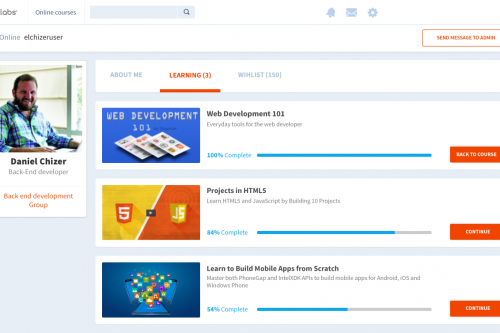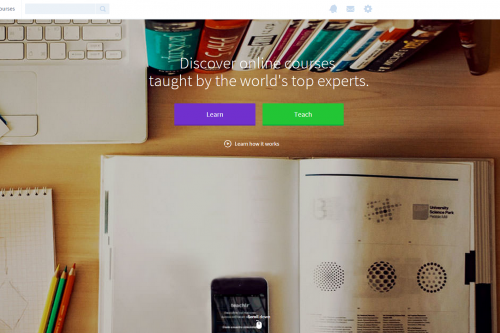When I was 9 years old, “Little Treasury of Dinosaurs” by Isaac Asimov was my favorite reading. What can I say… I loved dinosaurs and I wanted to be a paleontologist. I was clearly motivated and wanted to learn all about dinosaurs.
Learning and motivation are directly related. People motivated for learning do more research, spend more time and take the best out of the resources they have.
Even when motivation is different for everyone and changes in time, as an instructor, there are many basic things you can do to keep your students interested and encourage them to take full advantage of your online course.
Keep reading to learn more about motivation, elearning challenges when it comes to bolstering your students enthusiasm and our tips for keeping your students engaged.
Motivation
Let’s think for a second: why do we do what we do?
Motivation is a complex subject. Researchers say that motivation can come from two different sources:
- Extrinsic, it’s the one that does not come from our inner self, but the outside world. This is why we make our beds every morning (ok, most mornings) and why we do all those things we don’t like, but that at the end of the day are good for us.
- Intrinsic, on the contrary, this type of motivation does come from our inner self and makes us do the things we love. This is why we dedicate a great amount of time on our hobbies, or side projects that might then turn into big things.
Nevertheless, the debate is not settled. Researchers also say that we are much more complicated, as motivation also comes from the addition of our basic desires and change in time.
On e-learning and online courses, the intrinsic component of motivation is very high. Students enroll in the course because they choose to, right? Well, yes. However, we are all different, which meansthat there are reasons to believe that our motivation don’t come from the same place: I want to learn something to improve my career (extrinsic motivation), I need to learn some skills in order to start my own business and pursue my dream (also extrinsic motivation).
This is why the role of instructors is so important: Instructors must make sure that, whatever drove students to enroll in a course, that initial motivation should remain and grow even stronger throughout the course.
E-Learning Challenges
Online education presents many benefits to the ones who want to teach: it is the channel to break geographic barriers and reach more people with your knowledge. But there are also downsides.
One of them is the lack of real-time interaction. Students’ faces are a precious insight for anyone who has ever taught in a traditional environment.
On an online course, you can’t see those faces and act in consequence. Therefore, it is harder to share emotions with your students: How to know if they are understanding what I just said?, or if they know how much I love this topic? If they laughed of that joke? How to know all this, if we are standing in front of a camera?
On the other side, there are the students. They suffer as well for this lack of real-time interaction. Students usually have questions like: Am I getting this right? And how do I use this on the real world?
So, we did a quick search looking for questions like those in several courses published on Teachlr and found that most of the students’ questions were related to finding out the instructors’ opinions and not about validating what they have learned.
Not being on a social context changes the learning conditions for both students and teachers. Being aware of these limitations will help you create a great online course and keep your students engaged from the first lecture to the last one.
5 Tips for keeping your students engaged
1.- Know your students
The road to success for an online course starts way before it is published.
If you already have an idea about the topic of your next course, the next step is to research about the people that is willing to take it.
Knowing your audience will help you define which are the best strategies to reach this people, what is the language they speak (e.g. is it formal or informal and so on) and which are the best formats for the materials you’ll share.
The most important finding you will make on this research is about what your audience needs: What do they need to take out from your course? What is their goal? Having these answers will allow you to create relevant content for all your students.
Define the objectives of your course clearly, this way your future students will know beforehand if your course is right for them and what to expect from it.
2.- Don’t forget about the technical details
Once you know who your students are, the next step is to create your course index. Think about what they will learn and how this will help them get closer to their goals (you can make a copy of our Index Course Template here).
Now, it’s time to start thinking about the recording of your course.
Audio and video quality have a huge impact on your students. A bad lighting or a background sound that causes distractions may disengage many of your students from continuing with your course, even when its content is really good.
We are not all experts regarding the technical aspects of recording, so here is a list with 5 tips for creating your online course that we published some time ago.
In short, it can be summarized to:
- Be careful with the lighting. Place all lights in front of you and any behind you. This way your face will look clear, without any unwanted shadows.
- Choose the right place. Outdoors are beautiful, but they are also difficult to control: environmental sounds and daylight changes are just two examples of what might happen. That’s why we highly recommend that you shoot your course indoors with a plain background.
- If you’re going to use a musical background for your course lessons, make sure its volume is right for listening to your voice.
Ah! And if you’re thinking on creating a screencasts only course, keep in mind that breaking the distance imposed by the online environment is pivotal in maintaining your students motivated. So, let them see you! Introduce yourself in one of the videos and show them who you are, as it will help you get closer to your students.
3.- Take care of every aspect of your communication
You’re not watching your students when they take your course. Conversely, students do get to see you and make ideas about you based on how you communicate with them. Not so fair, right?
Your posture, movements, voice tone and the words you choose will have a big effect on their learning experience and their motivation for continuing with your course.
Therefore, you should be careful about what you say (your course content) and what you don’t say with words, i.e. your body language. Just an interesting figure to illustrate the point: Nonverbal communication has an impact of 70% in what we communicate.
Throw your shoulders back to improve your posture. This will make you appear more trustworthy and comfortable. Accompany your words with the movements of your hands so they support what you’re saying: your hands let you prioritize different points, display processes and sequences, contrast two concepts and so on.
A very important resource you count with is your voice. Use the volume of your voice to emphasize the most important parts of your speech and make pauses in your narrative to let your students think. Be conscious of the tone of your voice as Prof. Rafael Briceño recommends:
If you have a high tone, don’t speak too fast and if you have a low tone, pay special attention to your modulation.
When choosing the words you’re going to use to explain each concept, avoid using technical jargon, unless it is necessary, because it creates a barrier between you and your students. And no matter if you’re using technical language or not, always include practical examples to show your students what is behind each concept.
4.- Encourage participation
How to know if your students are really understanding and learning everything in your course? Well, by asking them.
But don’t ask them void questions like: “did you get it?” “Any questions?”. That works on a traditional classroom because you can see your students.
To really know what your students have learned you need to create spaces for participation, such as discussion forums that are aligned with your students goals.
Vilma Núñez, strategic consultor, Ph.D, professor and international speaker, shared her advice with us:
“In an online course, practical activities are fundamental to ensure that the course has added value to your students and that they are able to put into practice the lessons you’ve taught.
In order to maintain your students active, you should keep an active communication with them. You can do this through private groups on networks such as Facebook. These groups work as a support forum for their questions, but the most but most importantly, you must help them side-by-side put into practice what they’ve learned with you.
I publish challenges in these groups and offer them incentives. Results are amazing: they don’t only lose the fear to implement what they’ve learned, but also achieve great results on their own projects”.
Online students value their autonomy, this is why you should offer them several options for communication and participation.
On Teachlr, for example, students can make questions inside each lesson. Go beyond just answering questions and encourage the use of this space to create a community inside your course.
Another interaction tool you count with in our platform are quizzes. They will help your students validate their new knowledge and achieve small goals that motivate them to take the next lesson.
Finally, you can use our public channel tool to make webinars and improve the real time communication with your students.
5.- Run a test
So far we have covered many aspects you should take into account before creating your course. If you are ready to start recording your online course, but you still think you can go further in order to ensure students motivation, there’s something else you can do.
Set everything up and record a lesson, then use this video to test how people react to it. Show this video to people you know and ask them their comments on topics as lighting, volume and everything we talked about on this post.
Additionally, you can improve the reach of this test by publishing your video on YouTube, Facebook or any social network you like. Listen to the comments of your viewers, as it will give you an idea on how your students will react (besides it works as a marketing resource for your future course).
Summarizing:
- Research to find out the needs of the people who might take your course.
- Plan every detail and aspect of your course: content, videos, nonverbal communication.
- Create spaces for feedback and interaction.
And although today I only use my knowledge of dinosaurs to show off while watching Jurassic Park (which is not so “Jurassic”), I know something for sure: we learn better when we are motivated and that knowledge always stays with us.
What do you think? Is there any strategy or technique you would like to talk us about? Well then, just leave it in the comments below.
If you want to start creating your online course, you can go to Teachlr.






